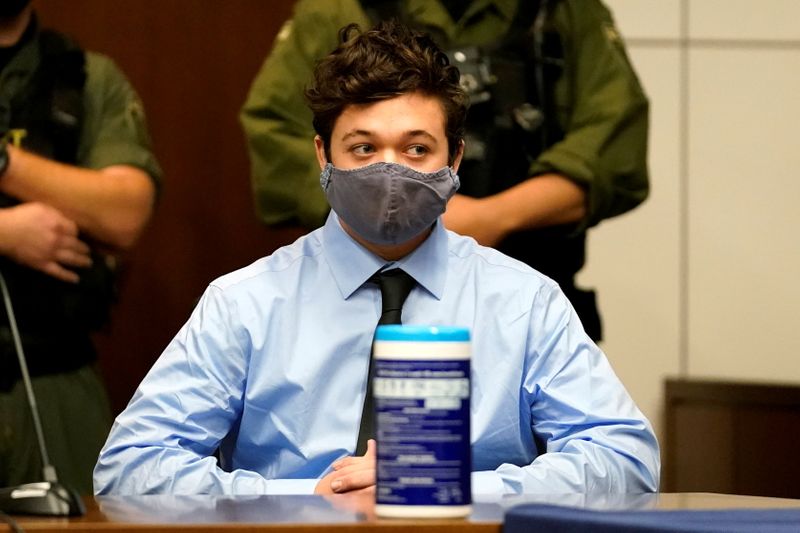By Nathan Layne
(Reuters) - One of those fatally shot by Kyle Rittenhouse threw a plastic shopping bag containing socks and a deodorant stick at him before appearing to try and grab his rifle. Another struck the teenager with a skateboard. The third person shot was brandishing a handgun when Rittenhouse fired his final round.
Rittenhouse, 18, has been charged with killing two men and wounding a third during demonstrations in Kenosha, Wisconsin, on Aug. 25, 2020. The protests were sparked by the shooting of a Black man, Jacob Blake, by a white police officer a few days earlier. Blake was left paralyzed from the waist down.
As Rittenhouse prepares for trial next week, the chaotic circumstances surrounding the shootings present a formidable challenge for prosecutors, who will seek to portray the teenager as a vigilante killer, legal experts said.
Rittenhouse, who was 17 at the time of the shootings, has pleaded not guilty and is considering taking the stand to offer a firsthand account of his self-defense claims, two people familiar with the matter said.
"If you asked me would I rather be the prosecutor or the defense attorney right now, I would rather be the defense attorney," said Tom Grieve, a criminal defense lawyer in Milwaukee and former prosecutor. Absent surprise evidence emerging at trial, he added, "This is a strong case for the defense."
The trial, which kicks off on Monday with jury selection, is arguably the highest-profile test of a civilian's right to self-defense since George Zimmerman was acquitted in the fatal shooting of Trayvon Martin, an unarmed Black teenager, in 2013.
The judge overseeing the trial has vowed to prevent it from becoming political, even as debates over race, guns and policing have raged online in connection with the case.
Rittenhouse, who is white, has emerged as a cause celebre for many conservatives in the perennial battle over gun rights in the United States. He was also viewed by some on the right as a timely counterpoint to the sometimes violent protests against police brutality that rocked large U.S. cities last year. Days after the shootings then-President Donald Trump suggested Rittenhouse had acted in self-defense.
Under Wisconsin law, a person can only use deadly force if he or she "reasonably believes" it necessary to prevent someone from killing or causing great bodily harm to them.
Deciding what is reasonable will be up to a jury of 12 people from Kenosha County, a mix of urban, suburban and rural areas west of Lake Michigan that Trump narrowly won last year.
How sympathetic the jury is to Rittenhouse may shake out along partisan lines, with a right-leaning juror more likely to believe he had a right to defend himself and a more liberal juror more apt to fault him for going out that night armed, said Marquette University Law School Professor Michael O'Hear.
DEFENSE
With ample bystander and surveillance video available as evidence, there is little dispute over what transpired and the two sides are mainly fighting over how to interpret the facts.
Rittenhouse, a resident of nearby Antioch, Illinois, is facing seven charges, including homicide in the fatal shootings of Joseph Rosenbaum, 36, and Anthony Huber, 26, and attempted homicide for wounding Gaige Grosskreutz, 27.
Prosecutors are expected to argue that Rittenhouse, who was armed with a military-style semi-automatic rifle and says he was in Kenosha to help protect a business, was looking for violent conflict.
The defense will likely try and portray the men he shot as bad actors involved in lawless behavior that night, giving him reason to fear for his safety.
But prosecutors will likely say Rittenhouse reacted with disproportionate force, regardless of whether the three men were involved in any wrongdoing prior to their encounters with him.
"Their behavior that night has nothing to do with this case, unless it was witnessed by the defendant," Kenosha County Assistant District Attorney Thomas Binger said in a hearing this week. "His state of mind is the most important thing."
Video shows Rosenbaum charging at Rittenhouse when he was gunned down. A reporter named Richard McGinnis told police that Rosenbaum, who threw a plastic bag at the defendant but was unarmed, tried to grab the barrel of Rittenhouse's rifle, according to a criminal complaint filed last year. McGinnis is expected to testify at trial.
Rosenbaum's actions could have caused Rittenhouse to fear his own weapon would be used against him, said Benjamin Van Severen, a defense attorney in Milwaukee. He said law enforcement officers are regularly exonerated for shootings when someone has tried to seize their firearm.
Van Severen said proving that Rosenbaum's death was unlawful was central to the prosecution's entire case given that it appears to have prompted a crowd to start pursuing Rittenhouse, setting the stage for the other shootings.
Prosecutors have said they have FBI surveillance video showing that Rittenhouse followed and confronted Rosenbaum, evidence they could use to try to prove he was the aggressor.
As Rittenhouse flees the scene of the first shooting, protesters can be heard yelling things like "Get his ass!", according to the complaint. Rittenhouse then stumbles and falls to the ground and shoots Huber, a protester who was swinging a skateboard at him, according to video evidence and the complaint.

Grosskreutz, who was holding a pistol, took a step back and put his hands in the air before then moving toward Rittenhouse, who opened fire again, shooting him in the arm.
"It's not a slam dunk," said Keith Findley, a professor at the University of Wisconsin Law School, referring to the prosecution's case. "I think they are going to have some challenges."